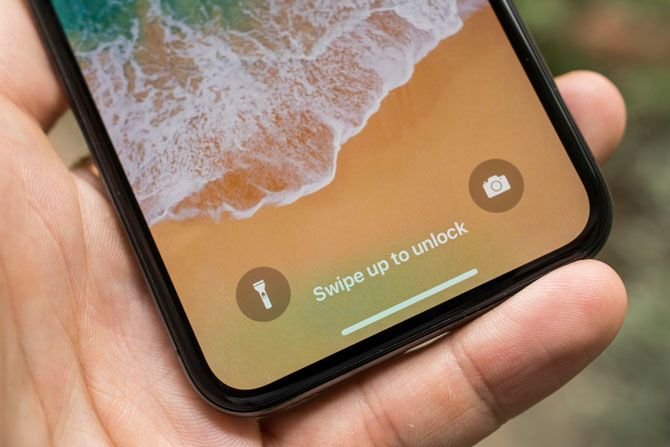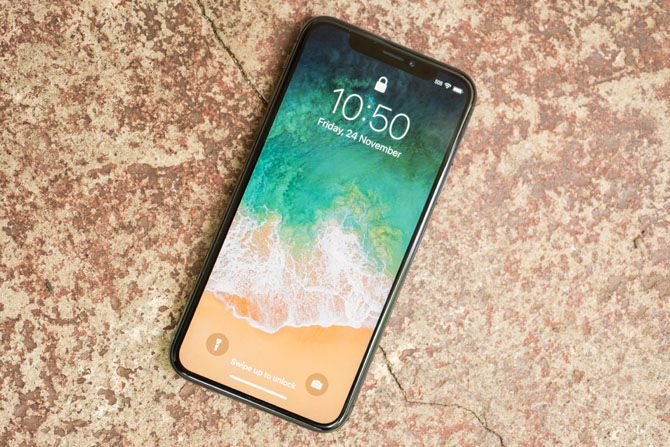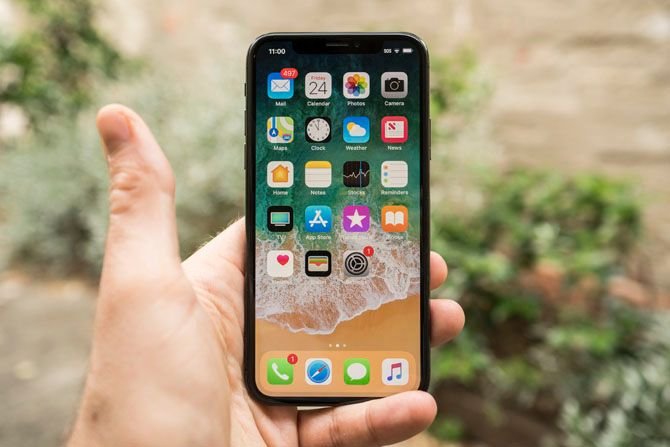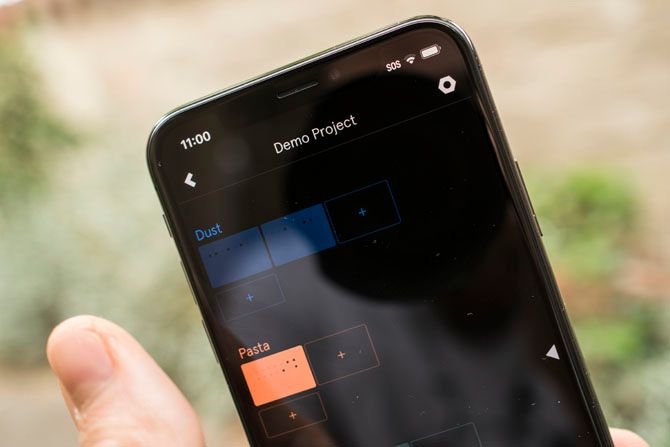
The iPhone X sits alongside the iPhone SE as the second non-numbered, black sheep of Apple’s smartphone family. It brings with it entirely new ways of interacting with iOS, and it’s more expensive than any iPhone that came before it.
It’s also pronounced “iPhone ten” — just in case you were wondering.
Out With the Old
I’ve spent several years complaining about the lack of change in terms of overall design to the iPhone, while still managing to be impressed by Apple’s overall attention to detail. This time round I’m both impressed by the detail, but also the way the iPhone X reinvents basic interaction.

In terms of size, the iPhone X is somewhere between an iPhone 8 and the Plus model. Compared to the Plus, it’s slightly smaller overall, which makes it easier to grip, more pleasant to use with one hand, and easier to fit into a pocket. Despite being smaller, the screen is actually larger than the 5.5″ panel in the Plus model, at 5.8″ diagonal on the iPhoneX.
That’s because the entire front of the iPhone X is occupied by the display. From the lower edge right up to a small cutout at the top of the device, the iPhone X does away with the Home button entirely in favor of software-driven gestures. While last generation’s iPhone lacked a mechanical home button, the new generation lacks the button itself.
There’s a notch cut out of the screen at the top of the device for a speaker, front-facing camera, and Face ID sensors. Despite causing some division among armchair pundits, I actually think it looks pretty good. There’s a Star Trek-esque quality to the rounded cutout, and despite being an unavoidable design decision for Apple, I like the rounded edges and the way it contrasts with the screen.

The notch has an inescapable effect on how the user interface works, with elements like the time, battery and signal strength shoe horned into the cramped top corners. The information is still only a glance away, and all this extra screen space feels like something-for-nothing compared to older iPhones.
There are some big changes to button placement too. The physical Home button is entirely absent, replaced instead with gestures. The power button on the side of the device is now longer, and performs a few more actions, like invoking Siri. In many ways it’s the new home button, used for locking the screen, taking screenshots, and shutting down the device only with the right combination of button presses.
On the back, it’s largely business as usual aside from the now-vertical dual lens camera stack. There’s also a wireless charging plate somewhere in there, which is compatible with Qi chargers just like the iPhone 8. And just like the 8, it’s all glass, and as prone to breaking as the front panel is. Fragility aside, the glass feels great in the hand, just like the iPhone 4 did.
The iPhone X is a well-balanced device.
It’s still unmistakably iPhone, and it retains that premium feel thanks to the quality materials and ergonomic design.
A New Smartphone Experience
Learning to use the iPhone X will take considerably longer than your usual iPhone upgrade. There’s a lot of new things to get used to. You’re probably going to default to the same muscle-memory techniques you’ve developed over the past decade, but many of them are now defunct.

Swipe to Home is probably the biggest change in terms of everyday use. I found myself reaching for an absent home button multiple times when I started using the X. You now swipe up from the bottom bezel to head back to the home screen. It’s a responsive gesture, and it works whether you’re using a fast flick or a cautious swipe.
Switching apps has also been complicated, since you can no longer double-tap the home button. You can now switch between apps with a swipe and a hold, or if you’re impatient a swipe and a flick to the right. This probably doesn’t sound particularly intuitive, but once you’ve had a play with the device you’ll know what to do and it’s then simply a matter of remembering it.
A new reliance on flicks and gestures means Apple has changed how apps are “killed” using the app switcher. You now have to tap and hold an app for the “kill” button to appear before you flick upwards. This is probably a good thing, since the only time you should be killing apps is when they crash and become unresponsive.
Something many Android phones have had for a long time is knock to wake, and now the iPhone X has it too. No home button means Apple had to implement some method of waking the phone up that didn’t rely on movement. Tap the screen and the X will wake, and because the whole front of the device is essentially a screen you can tap anywhere.
The screen itself offers a new way to iPhone. It looks inescapably futuristic, and you feel like you have more phone to play with since many apps have already updated to take advantage of the bigger screen. Elements like media controls, or titles at the top of the screen now occupy what was previously “dead space” so there’s just more content on screen at once. This leads to better app, reading, and browsing experiences.
In terms of imaging, the camera is largely unchanged from the iPhone 8 Plus. You get a dual lens design, with a 2x optical zoom on the telephoto lens. Like the 8, the X gets improved signal to noise ratio and software enhancements that make for cleaner images, better low light performance, and faster autofocus thanks to the A11 Bionic chip.
The front-facing camera comes with the depth-effect Portrait mode, as well as Apple’s new funky faux lighting effects which simulate studio lighting, spotlights and so on. It feels more like a gimmick than anything particularly useful, but it’s fun to mess around with. Overall the camera is up to snuff, but still suffers from the many problems that plague small sensors like difficulty achieving real depth of field, and poor low light performance compared to larger sensors.
Face the Changes
The really big change is the addition of Face ID. The iPhone X uses infrared to scan your face and create a likeness that can be used to do everything Touch ID could do previously. This scan is taken from multiple angles, which is similar to the way Touch ID would scan the edges of your fingerprint.
Does it work? Yes it does. It works incredibly well. I’ve only had it fail once, and by the time I’d swiped up from the lower bezel Face ID had re-scanned my face and already authorized me. I wear glasses all the time, including polarized aviator-style prescription sunglasses and I have plenty of facial hair too. I’m very impressed (and a little bit relieved) with how well Face ID works.
Remember Touch ID on the iPhone 5s? Remember how it was slow to react, prone to failure, and wouldn’t work when your fingers were wet or greasy? Face ID solves pretty much all of those problems. It’s fast. So fast that by the time you’ve thought about unlocking your phone it’s already unlocked. There's no doubting that Apple's iPhone 5S introduces one of the best implementations of fingerprint scanning, but it's not been plain sailing for everyone.
This is an example of how the iPhone X changes the iPhone experience. Unlocking your iPhone is now a process that disappears into the background and happens invisibly. You’ll stop consciously trying to unlock your phone, because it just works.
Face ID helps elevate the iPhone X beyond a simple design refresh. This is the future of biometric authorization. Whether we’re scanning our faces or using microchips embedded in our palms, the process is automatic and delivers a noticeable leap forward in speed and convenience.
A feature called Attention checks whether or not you’re look at the device, to add an additional layer of security. This also prevents the iPhone from dimming the screen while you’re looking at it. You might have to turn off Attention if you live your life in sunglasses, since it doesn’t work so well when your eyes are obscured.
There are other cool things you can do with Face ID, like Apple’s new Animoji. This feature lets you use your real facial expressions on an emoji character, including everyone’s favorite poop. This is fun, but I’m a little disappointed about mouth movements since my Animoji characters don’t really look like they’re talking.
There are of course some privacy concerns with scanning your face. The iPhone X uses a mathematical approach to authorization, while also taking a likeness of your face that can be shared with third party apps with your permission. Apple insists your facial scan never leaves the iPhone, but they can’t necessarily control what third parties do with your likeness — so be careful which apps you authorize.
The Price You Pay
I love the iPhone X, mostly because it’s a sign of the times in terms of what to expect going forward in an iPhone. It’s first real big leap forward since iOS 7, or Touch ID. More screen real estate is always a good thing, and this time round it’s a great thing considering how much dead space has been recovered. I’m fond of the gestures, and I don’t mind the size of the device coming from an iPhone 7 Plus.
Unfortunately, there’s always a drawback. With Apple, it’s usually the price, and the iPhone X is no different. The phone starts at $999 for the 64GB model, and personally I’d expect at least 128GB for that sum. You can upgrade to a 256GB model for $1149 outright.
That’s the price of a good laptop. You could buy an iPhone 8 ($699) and the latest Apple Watch ($329) for virtually the same price. The price is only one part of the equation, since the iPhone 8 does many of the same things the iPhone X does. In essence, you’re paying for early access to the future of iPhone. It’s hard to say whether Face ID and a design shake-up justifies the $300 premium over the iPhone 8. You can ultimately evaluate the iPhone 8 without ever picking it up, if you own a 6s or 7. It's a refinement of what came before, with unrealized potential in its wireless and fast charging.
And then there’s all the stuff you probably should have received in the box, which is missing. The iPhone X is a wirelessly charging device, but there’s no wireless charger included and Apple’s own wireless charging isn’t coming till 2018. An iPhone X-compatible Qi wireless charger will cost you about the price of a good Lightning cable, but it’s an additional expensive on top of your $999 investment.
Even more egregious is the lack of a fast charger. The iPhone X can take advantage of fast charging, reaching 50% capacity within 30 minutes assuming it’s paired with the right charger. Apple included charger won’t do this. In fact, Apple recommends a further $75 for their charger and USB-C to lightning cable (though you can opt for third party chargers and spend half the price).
Wireless charging also feels a bit half-baked, though welcome. The Qi standard can deliver 15w max output, but the iPhone X only draws 7.5w. If you already have a few charging stations around your house, this won’t bother you. For $999 I’d expect something in the box, though.
One other problem I ran into is battery life. I settled on an iPhone 7 Plus for its heroic battery life, but the iPhone X only manages “two hours longer than an iPhone 7” according to Apple. This is odd, considering the size of the device, and it’s another reminder that consumer battery technology is virtually at a standstill at this moment in time.
If you bought a Plus model partially for the power gains, the iPhone X will likely disappoint. Maybe Apple plans on releasing an iPhone X Plus in the future that improves on this.
A Bright Future
You may have noticed that I didn’t really mention the A11 chip that powers the iPhone X. I feel like we’ve reached a point where this doesn’t really matter any more. The iPhone X flies, like any new iPhone should, and it’s likely to remain highly capable for a few years yet.
The iPhone X is a flagship, business-class device. It’s the first generation of a new generation, and such devices always come with a few pitfalls. It’s expensive, it doesn’t offer the value for money that other models do, and it’s a test run for Apple’s big new facial recognition technology.
It’s also an accomplishment that Apple should be proud of. It might not be the first example of facial recognition in consumer technology, but it’s the first time it’s worked so well.
Whether or not this experience is worth the money is tough to call. It’s a fantastic device, with a ton of great features, and it reinvents the way you interact and look at your iPhone. But the iPhone 8 does virtually everything the iPhone X does, for less money. Unless you’re hell-bent on this experience, buying an iPhone X might be hard to justify.
The future of iPhone and smartphones in general is bright. It’ll be really exciting to see how other manufacturers answer the iPhone X, and how Apple follows this up next year. Will we see Face ID on the iPhone 9? Fingers (retinas?) crossed.